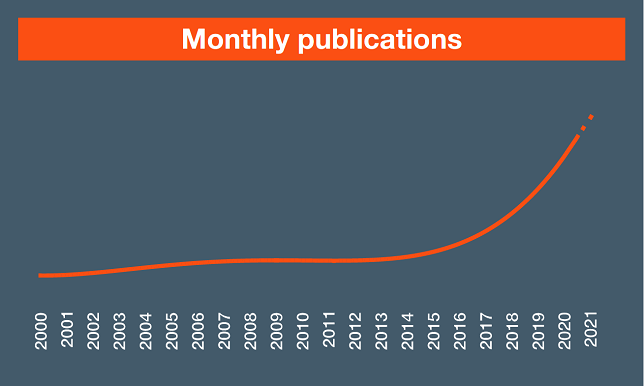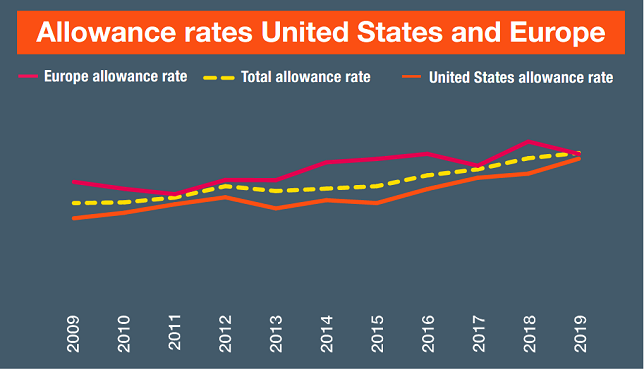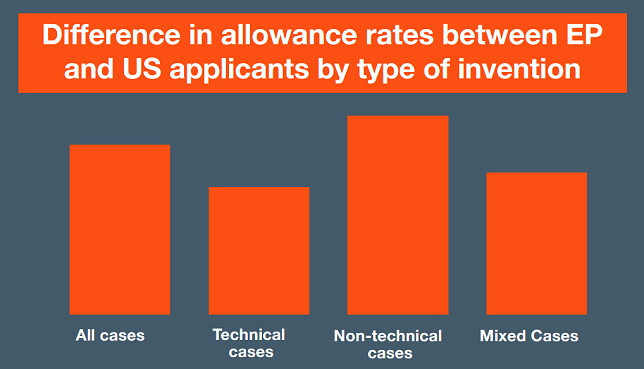Patent analytics can provide invaluable insights into emerging technologies, such as artificial intelligence (AI). Naturally as investment in AI-related research and development has surged in the past few years, so too has the number of patent applications being filed for inventions in this area.
By assessing those applications for our latest AI research reports, we have uncovered a number of important filing trends, in terms of frequency, geography, inventor and scope of protection. This article sets out some of the key findings from our analysis, which focused on patent filings at the European Patent Office (EPO).
Further detail can be found in our main report ‘AI patents at the EPO – a long-term trend analysis’, and in our supplementary report ‘Core AI patents at the EPO’. The latter focuses specifically on applications in IPC code G06N03 (“computer systems based on biological models”, which we call “core AI”), closed by the EPO since 2018.
For the purposes of our research, the definition of AI is based on classifications used in the WIPO Technology Trends report on AI, with some refinement of definitions based upon manual analysis of the dataset.
Charting an accelerating trend
It is clear to see that the number of published European patent applications relating to AI has grown significantly in the last few years. According to our analysis, around 650 applications were published each month through the first half of 2020, suggesting that the trend is not only accelerating, but will also continue to do so for the foreseeable future (see figure 1).

Figure 1: Patent application numbers for AI inventions.
Our research also reveals that the vast majority of applicants are based in the US or Europe, but that a recent increase in filings from Chinese applicants makes China the fastest growing originating country of AI applications at the EPO. While Chinese applicants made up only 1% of all AI applications published by the EPO in 2009, they accounted for 7% of all AI applications published by the EPO in 2019.
Astonishingly, of all “core AI” applications from Chinese applicants in the past 20 years, 92% were published since 2018. The recent growth in AI filings by Chinese applicants is expected to continue, particularly given the Communist Party of China’s plans to develop China into a leading AI power by 2030 (as announced in the “Next Generation Artificial Intelligence Development Plan” in 2017).
Grant rates are increasing too
Allowance rates for AI applications at the EPO have seen a steady increase over the last 10 years, from 40% in 2009 to 60% in 2019. This likely reflects increasing clarity from the EPO regarding what is allowable in AI, and computer-implemented inventions in general.
European applicants consistently achieved higher grant rates relative to US applicants. The difference in allowance rate was around 10% across the period of 2000-2019 (see figure 2).

Figure 2: Allowance rates by applicant country (Total/EU/US).
Allowance rates also vary significantly based on technology area, from 26% for AI patent applications relating to “Business” and “Banking and Finance”, to 65% for “Transportation”. This reflects the EPO’s approach to assessment of inventive step, where AI inventions that have a “technical” application are more likely to be considered inventive.
A larger proportion of US-originating AI applications fall into categories that are traditionally considered “non-technical” by the EPO (54% from US applicants compared to 43% from European applicants). Even so, European applicants have better allowance rates even when normalising for different proportions of “technical” and “non-technical” cases (see Figure 3). In fact, the difference in allowance rates of European and US applicants was greatest for “non-technical” cases at 11.5%, compared to 7.3% for “technical” cases. We see this as evidence of the value of applications being prepared with European requirements in mind. Indeed, it is not surprising to us that this value is greatest in more challenging, “non-technical”, cases where excluded subject matter objections are more likely to arise. Accordingly, improvements in grant rates for non-European applicants could potentially be achieved by seeking input from a European patent attorney earlier in the process; for example, during patent drafting.

Figure 3: Difference in allowance rates between EP and US applicants by type of invention.
Choosing the right support
Marks & Clerk leads the way in prosecuting AI applications in Europe. In fact, our specialist team has filed more AI applications at the EPO than any other firm since 2015, and has a success rate for those applications that is 13% higher than the average across the same period.
In “core AI” cases, Marks & Clerk again had the highest success rate of any firm of European patent law attorneys (excluding firms handling only a single case). Of Core AI applications handled by Marks & Clerk, 83% were granted, compared to the overall success rate for all attorney firms of less than 50%.
Find out more
For further details, including a breakdown of grant rate and filing numbers for specific technology areas, please download the main report or our report on Core AI.
Further analysis, including industry-specific reports, will also follow in due course. In the meantime, if you have any questions regarding the protection of AI innovations in Europe or our analysis, please get in contact with one of Marks & Clerk’s AI team.



